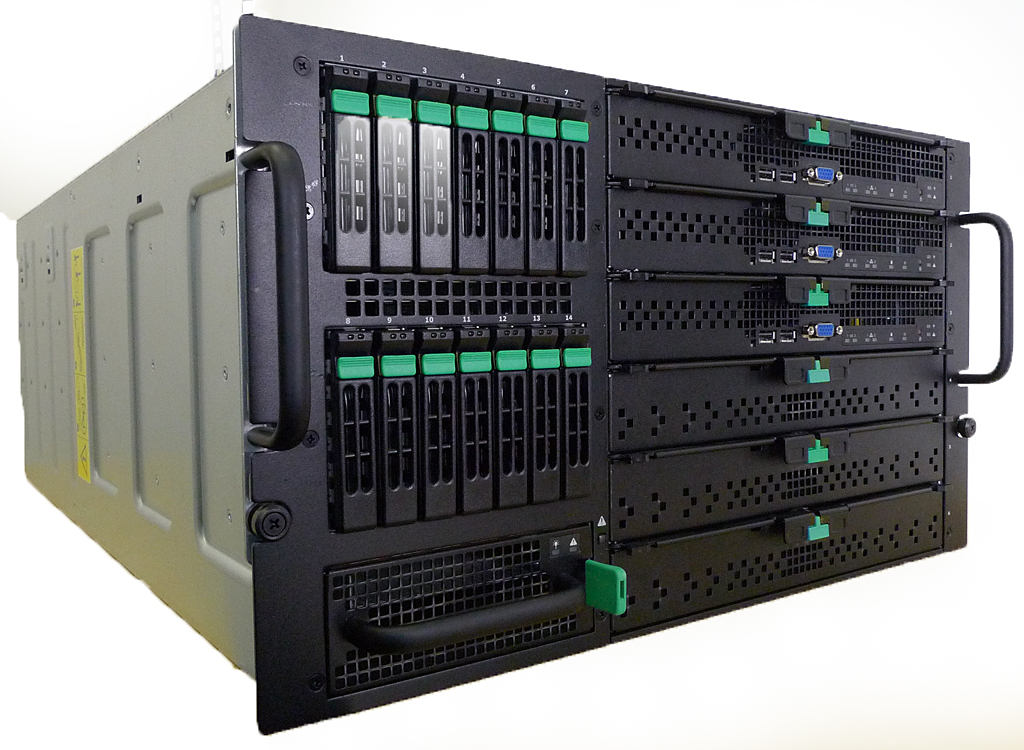Intel’s 24-Core, 14-Drive Modular Server Reviewed
Introduction
Ed: Julio Urquidi designs and manages Windows and Linux servers at a large medical center.
Let's say you're part of a small company that has identified a satellite office with some extra space, and you are tasked to set up a couple of servers that would be low maintenance, reliable, and compact. Perhaps, you also need the flexibility to add a couple more servers, but are restricted by power requirements and hardware costs. You might also work for a small- or medium-sized business that needs to add a system that provides redundancy and easy-to-use administrative tools that won’t kill your budget.
The Intel MFSYS25 Modular Server System may be the server solution you are looking for.
The MFSYS25 is a flexible chassis-based system that has room for six server-like compute modules. It offers networking with an Ethernet switch module and includes a built-in SAN (storage area network) that holds 14 2.5” SAS drives and can be shared between server modules. The chassis and its components are all managed through a Web-enabled administration tool. Overall, the MFSYS25 is designed to provide a remotely managed environment that is robust and stable with redundant power, storage, and cooling for up to six servers.
Using Intel’s Multi-Flex architecture, the rack-based MFSYS25 puts a lot of power into a relatively small server footprint for small- to medium-sized businesses and remote offices. Using 4 GB DIMMs, the total memory capacity can reach up to 192 GB of RAM if you pack each of the six available Compute Modules with 32 GB of memory. The system is uniquely flexible, as it enables easy administration in setting up storage pools within the MFSYS25’s SAN. In turn, this allows the administrator to assign the disks in these pools to the compute modules in multiple options of RAID configurations. The system supports up to 12 dual-core and quad-core Xeon processors, and up to two processors per server module, giving the MFSYS25 plenty of horsepower to run today’s apps.
Note: The MFSYS25 is one of two Intel modular servers. The other modular server in the line, called the MFSYS35, is different in that is can hold six 3.5” SATA or SAS drives.
Our demo system consisted of the following;
Get Tom's Hardware's best news and in-depth reviews, straight to your inbox.
- One MFSYS25 chassis
- Three MFS5000SI compute modules,
- One Ethernet switch module
- One management module
- One storage controller module
- 14 2.5" SAS hard drives
- Three power supply modules (fourth Power Supply not used)
- Two main cooling modules
- One I/O cooling module
-
kevikom This is not a new concept. HP & IBM already have Blade servers. HP has one that is 6U and is modular. You can put up to 64 cores in it. Maybe Tom's could compare all of the blade chassis.Reply -
sepuko Are the blades in IBM's and HP's solutions having to carry hard drives to operate? Or are you talking of certain model or what are you talking about anyway I'm lost in your general comparison. "They are not new cause those guys have had something similar/the concept is old."Reply -
Why isn't the poor network performance addressed as a con? No GigE interface should be producing results at FastE levels, ever.Reply
-
nukemaster So, When you gonna start folding on it :pReply
Did you contact Intel about that network thing. There network cards are normally top end. That has to be a bug.
You should have tried to render 3d images on it. It should be able to flex some muscles there. -
MonsterCookie Now frankly, this is NOT a computational server, and i would bet 30% of the price of this thing, that the product will be way overpriced and one could buid the same thing from normal 1U servers, like Supermicro 1U Twin.Reply
The nodes themselves are fine, because the CPU-s are fast. The problem is the build in Gigabit LAN, which is jut too slow (neither the troughput nor the latency of the GLan was not ment for these pourposes).
In a real cumputational server the CPU-s should be directly interconnected with something like Hyper-Transport, or the separate nodes should communicate trough build-in Infiniband cards. The MINIMUM nowadays for a computational cluster would be 10G LAN buid in, and some software tool which can reduce the TCP/IP overhead and decrease the latency. -
less its a typo the bench marked older AMD opterons. the AMD opteron 200s are based off the 939 socket(i think) which is ddr1 ecc. so no way would it stack up to the intel.Reply
-
The server could be used as a Oracle RAC cluster. But as noted you really want better interconnects than 1gb Ethernet. And I suspect from the setup it makes a fare VM engine.Reply
